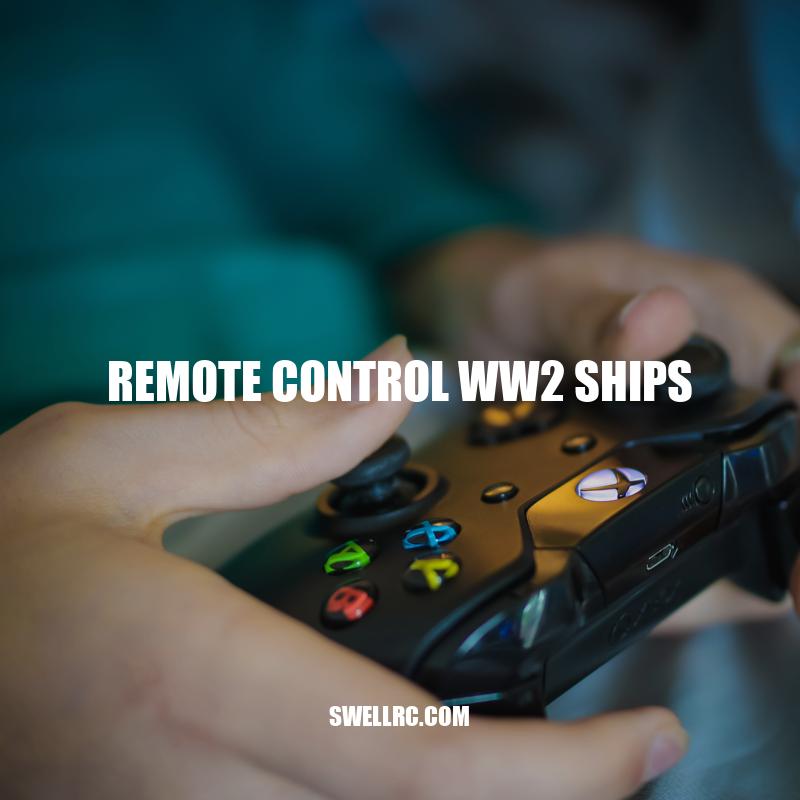Remote Control WW2 Ships: Modeling Techniques, Building Tips and Operability
Remote control WW2 ships have become a popular hobby among enthusiasts over the years. These models are designed to resemble the famous battleships, cruisers, and aircraft carriers that played a significant role in World War II. The combination of history, technology, and craftsmanship make these model ships a fascinating and engaging hobby. With advancements in remote control technology, building and operating remote control WW2 ships have become more accessible and enjoyable for people of all ages and skill levels. From assembling the model to positioning and shooting, operating a remote control WW2 ship requires a high level of precision, attention to detail, and strategic thinking. Whether you are a history buff, a technophile, or a creative person, the hobby of remote control WW2 ships offers you an excellent opportunity to learn, have fun, and showcase your skills. In this article, we explore the world of remote control WW2 ships, including types of ships, building techniques, operating tips, and future trends.
Types of Remote Control WW2 Ships
Remote control WW2 ships come in a variety of different types, each with unique features and capabilities. Some common types are:
- Battleships: the largest and most powerful ships in the fleet, built to withstand heavy gunfire and torpedo attacks
- Cruisers: slightly smaller than battleships, with a combination of speed, firepower, and armor
- Aircraft carriers: ships designed to launch and recover planes, and provide support for fleet operations
- Destroyers: smaller but faster and more maneuverable ships, designed to protect larger ships from submarines and other threats
Model ships of each type can be found in varying sizes and levels of detail. Some enthusiasts enjoy building large, highly detailed models that can take months or even years to complete. Others may prefer smaller, simpler models that can be built and operated more quickly.
For those interested in purchasing a remote control WW2 ship, there are several websites and retailers that offer a wide selection of models. Some of the most popular sites include:
- ModelWarships.com: a comprehensive site that offers a huge selection of WW2 ship models, from battleships and cruisers to submarines and aircraft carriers. This site also provides a wealth of information on modeling techniques, painting tips, and other resources.
- Hobbylinc.com: a retailer that specializes in model kits and accessories, including remote control WW2 ships. They offer a vast selection of models from various brands, along with tools, paints, and other materials needed for building and operating.
Whether building or operating remote control WW2 ships, enthusiasts can enjoy the combination of history, technology, and creative expression that this hobby offers.
What are the two different types of ships?
There are several types of ships, but they can be broadly categorized into two types: cargo ships and passenger ships. Cargo ships include container ships, bulk carriers, tanker ships, offshore ships, and special purpose ships. Passenger ships cater to tourists and travelers and include luxury cruises, ferries, and other types of vessels. Naval ships, on the other hand, are designed for military operations.
Building Remote Control WW2 Ships
Building a remote control WW2 ship is a challenging but rewarding hobby that requires a significant amount of time and effort. Here are some steps to get started:
- Choose your ship: Select the type of WW2 ship you want to build, as well as the scale and level of detail you are comfortable with.
- Get your materials: Order or purchase a model kit that includes the necessary materials such as hull, superstructure, deck, weapons, and motorization kit. It is essential to have the right tools such as a knife, sandpaper, and paint.
- Assemble the ship: Follow the kit’s instructions, assembling each piece to create the ship’s basic structure. Pay attention to the details and be patient, as assembling the ship will take considerable time and precision.
- Add details: Once the basic structure is complete, add the ship’s details such as gun turrets, bridge, masts, and antennas. You can also paint the ship with colors and markings that represent the historical period accurately.
- Install the motor: Finally, install the remote control system and motorization kit. This will require some electrical work, including wiring the electronics, installing the battery, and connecting the motor. Once everything is connected, the remote control WW2 ship is ready to operate!
It’s worth noting that building a remote control WW2 ship requires patience, precision, and attention to detail. However, the end result is a unique and detailed model ship that can serve as a source of pride and accomplishment.
For enthusiasts who want to take their building skills to the next level, some websites offer advanced modeling techniques and tutorials. One of the most popular tutorial websites is ModelShipWorld.com, which offers detailed instructions, tutorials, and forums where users can exchange ideas and ask questions.
Here is a table that compares different types of remote control WW2 ships:
| Type of Ship | Size | Complexity | Recommended For |
|---|---|---|---|
| Battleship | Large | High | Experienced builders |
| Cruiser | Medium | Medium | Intermediate builders |
| Aircraft carrier | Large | High | Experienced builders |
| Destroyer | Small | Low | Beginner builders |
Can you build your own remote control car?
Yes, you can build your own remote control car with prepackaged kits or separate electronic components. Homemade chassis can also be made from plastic. By doing this, you can customize your options such as the paint color, motor, and engines for a unique toy car. You can find RC car kits and separate electronic components at hobby stores or online retailers such as Amazon, HobbyPartz, and Banggood.
Remote control WW2 ships offer enthusiasts an exciting way to recreate the history of naval warfare in their homes or on the lake. To make the most of your model, it’s important to have the right equipment, technique, and knowledge.
Finding the right location is the first step to operating a remote control WW2 ship safely and effectively. Look for a body of water that is large enough for your ship to operate without any obstructions, such as a lake or pond. Avoid areas with strong currents or waves that could cause your ship to capsize.
Before heading out, make sure that your remote control equipment is working correctly. Charge your battery fully, check your transmitter, and receiver components, and be sure to follow the instructions detailed in the user manual. Once you arrive at your chosen location and have assembled your model ship, it’s time to launch it safely into the water.
With your remote control in hand, you can steer and speed up your remote control WW2 ship. Keep an eye on the ship’s speed and keep it level when moving fast. Avoid collisions with other ships, especially when participating in competitions.
Joining online communities such as Reddit’s r/radiocontrol and r/modelboats is a fantastic way to connect with other model ship enthusiasts. You can share your model building and operation experience and even find information about upcoming competitions. Remote control WW2 ships can also be great educational tools and are used in various competitions worldwide, like the International Small Scale Steamers, the World Model Soldier Federation, and the Model Engineering Exhibition, where enthusiasts can demonstrate their model operation and design.
In conclusion, remote control WW2 ships provide not only a fun hobby but also offer a great opportunity for learning and skill-building. With the right equipment, location, and techniques, enthusiasts can bring history alive and enjoy quality time on the water.
How do you set up a remote control?
To set up a remote control, first power on the device you want to connect it with. Insert batteries into the remote and point it directly at the device. Then, press and release the corresponding device button on the remote. Finally, press the power button and the device button simultaneously. For more detailed instructions, check out the website or product manual for your specific remote.
Conclusion and Future Trends
Remote control WW2 ships are not only a fun game to play, but also an educational tool for understanding the naval history and warfare strategy of the past. Model enthusiasts can either build or buy these incredibly detailed and historically accurate models and operate them in various locations, including ponds, lakes, or dedicated model ship locations. With the right equipment and technique, enthusiasts can navigate their ship through the water, performing maneuvers, or participating in model ship competitions.
In the future, technology will continue to advance, and new models will emerge as enthusiasts continue to push the limits of design and performance. We’re seeing the rise of fully functional and realistic models, using technologies such as hydrodynamic modeling to create realistic seaworthiness and maintaining the ships’ structural integrity.
Furthermore, advancements in digital capabilities are opening up new opportunities for model enthusiasts to share ideas, designs and experiences online. Virtual reality and 3D printing will eventually allow model enthusiasts to design, build, and test their ships from the comfort of their own homes.
In conclusion, remote control WW2 ships offer enthusiasts a fantastic hobby, an opportunity to learn about history, and a chance to showcase their creativity and skill. With the continued growth of the hobby and the evolution of technology, we’re sure to see some exciting advancements in the world of remote control WW2 ships.



